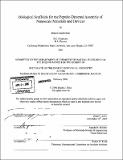| dc.contributor.advisor | Angela M. Belcher. | en_US |
| dc.contributor.author | Solis, Daniel J., 1978- | en_US |
| dc.contributor.other | Massachusetts Institute of Technology. Dept. of Chemistry. | en_US |
| dc.date.accessioned | 2008-02-28T16:24:40Z | |
| dc.date.available | 2008-02-28T16:24:40Z | |
| dc.date.copyright | 2006 | en_US |
| dc.date.issued | 2006 | en_US |
| dc.identifier.uri | http://dspace.mit.edu/handle/1721.1/34492 | en_US |
| dc.identifier.uri | http://hdl.handle.net/1721.1/34492 | |
| dc.description | Thesis (Ph. D.)--Massachusetts Institute of Technology, Dept. of Chemistry, 2006. | en_US |
| dc.description | Vita. | en_US |
| dc.description | Includes bibliographical references. | en_US |
| dc.description.abstract | The utilization of biological factors in the design, synthesis and fabrication of nano-scaled materials and devices presents novel, large scale solutions for the realization of future technologies. In particular, we have genetically modified the M13 Filamentous Bacteriophage for its use as a biological scaffold in the peptide-controlled nucleation and patterning of nanoscale semiconducting and magnetic materials. Through evolutionary phage display screening of inorganic substrates, functional peptides that influence material properties such as size, phase and composition during nucleation have been identified. The incorporation of these specific, nucleating peptides into the generic scaffold of the M13 coat structure provides a viable linear template for the directed synthesis of semiconducting and magnetic nanowires. Through further modification of the remaining proteins on the virus scaffold, other functionalities can be incorporated such as the directed patterning of the virus/nanowires assemblies into nanoscaled devices with tunable properties as determined by the genetic information carried within the virus scaffold. Multi-functional viruses provide a truly self assembled system for the design and execution of a myriad of nanoscaled devices in a green, scalable and cost effective manner. | en_US |
| dc.description.statementofresponsibility | by Daniel Joseph Solis. | en_US |
| dc.format.extent | 108 leaves | en_US |
| dc.language.iso | eng | en_US |
| dc.publisher | Massachusetts Institute of Technology | en_US |
| dc.rights | M.I.T. theses are protected by copyright. They may be viewed from this source for any purpose, but reproduction or distribution in any format is prohibited without written permission. See provided URL for inquiries about permission. | en_US |
| dc.rights.uri | http://dspace.mit.edu/handle/1721.1/34492 | en_US |
| dc.rights.uri | http://dspace.mit.edu/handle/1721.1/7582 | |
| dc.subject | Chemistry. | en_US |
| dc.title | Biological scaffolds for the peptide-directed assembly of nanoscale materials and devices | en_US |
| dc.type | Thesis | en_US |
| dc.description.degree | Ph.D. | en_US |
| dc.contributor.department | Massachusetts Institute of Technology. Department of Chemistry | |
| dc.identifier.oclc | 70851508 | en_US |
